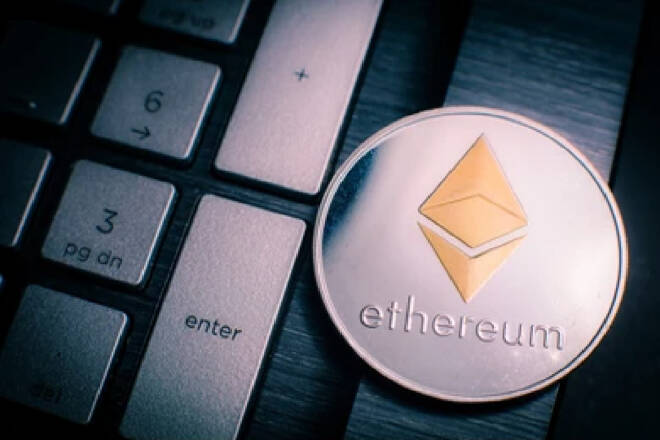Advertisement
Advertisement
ETH Bulls Eye a Return to $1,900 on Staking Inflows and SEC v Ripple Ruling
By:
ETH was on the move this morning. Staking inflows and the SEC v Ripple Court ruling delivered a bullish start, though US debt ceiling jitters will linger.
Key Insights:
- On Tuesday, ETH gained 0.44% to end the day at $1,825.
- Staking statistics and updates from the SEC v Ripple case delivered a bullish session.
- The technical indicators were mixed, signaling a choppy Wednesday session.
Ethereum (ETH) rose by 0.44% on Tuesday. Following a 0.94% gain on Monday, ETH ended the day at $1,825. Despite the bullish session, ETH fell short of the $1,850 handle for the sixth consecutive session.
A bearish start to the day saw ETH fall to an early morning low of $1,797. Steering clear of the First Major Support Level (S1) at $1,786, ETH rose to a late afternoon high of $1,833. However, falling short of the First Major Resistance Level (R1) at $1,848, ETH eased back to end the day at $1,825.
Staking Statistics and SEC v Ripple Court Ruling Deliver Support
According to CryptoQuant, staking inflows increased from 80,864 ETH on Monday to 153,536 on Tuesday. Staking inflows increased for the second consecutive session and neared the recent highs.
The total value staked jumped higher, supported by the upward trend in ETH staking inflows and the bullish ETH session.
However, the withdrawal profile was more bearish. Principal withdrawals spiked, which likely impacted buyer appetite. Withdrawal projections for the morning session were more bullish, with principal ETH withdrawals easing back.
Another sharp increase in staking inflows and subdued principal withdrawals would support a bullish session. On Tuesday, the net ETH staking balance rose from a surplus of 38,630 ETH to 89,500 ETH, equivalent to $163.33 million. Deposits totaled 97,080 ETH versus withdrawals of 7,590 ETH.
According to TokenUnlocks, total pending withdrawals stood at 40,850 ETH, equivalent to approximately $74.73 million.
While the staking statistics and withdrawal profile were bullish, updates from the ongoing SEC v Ripple case provided late support.
The Court denied the SEC’s Motion to Seal the Hinman documents, giving Ripple the upper hand in the SEC v Ripple case. A Ripple victory would be a boon for ETH and the broader crypto market, with an SEC loss likely to force lawmakers to give the CFTC more regulatory powers.
The Day Ahead
Staking statistics and the withdrawal profile will continue to draw interest. A slide in staking inflows and a spike in principal withdrawals would be bearish.
Investors should monitor the crypto news wires throughout the session. SEC v Ripple case-related news will move the dial, with Binance and Coinbase (COIN) also areas of interest.
There are no US economic indicators to consider. However, Fed chatter and US debt ceiling-related news will also need consideration.
Ethereum Price Action
This morning, ETH was up 0.48% to $1,833. A mixed start to the day saw ETH fall to an early low of $1,818 before rising to a high of $1,837.
ETH Technical Indicators
Resistance & Support Levels
| R1 – $ | 1,840 | S1 – $ | 1,804 |
| R2 – $ | 1,854 | S2 – $ | 1,782 |
| R3 – $ | 1,890 | S3 – $ | 1,746 |
ETH needs to avoid the $1,818 pivot to target the First Major Resistance Level (R1) at $1,840. A move through the morning high of $1,837 would signal a breakout session. However, ETH staking statistics and US debt ceiling updates must support a breakout.
In the event of an extended rally, the bulls would likely test the Second Major Resistance Level (R2) at $1,854. The Third Major Resistance Level (R3) sits at $1,890.
A fall through the pivot would bring the First Major Support Level (S1) at $1,804 into play. However, barring a risk-off-fueled sell-off, ETH should avoid sub-$1,750. The Second Major Support Level (S2) at $1,782 should limit the downside. The Third Major Support Level (S3) sits at $1,746.
Looking at the EMAs and the 4-hourly candlestick chart (below), it was a mixed signal. Ethereum sat below the 100-day EMA, currently at $1,846. The 50-day EMA narrowed to the 100-day EMA, while the 100-day EMA fell back from the 200-day EMA, delivering mixed signals.
A move through R1 ($1,840) would support a breakout from the 100-day EMA ($1,846) to give the bulls a run at R2 ($1,854) and the 200-day EMA ($1,858). However, a fall through the 50-day EMA ($1,826) would bring S1 ($1,804) and sub-$1800 Major Support Levels into view.
A fall through the 50-day EMA would send a bearish signal.
About the Author
Bob Masonauthor
With over 28 years of experience in the financial industry, Bob has worked with various global rating agencies and multinational banks. Currently he is covering currencies, commodities, alternative asset classes and global equities, focusing mostly on European and Asian markets.
Advertisement
